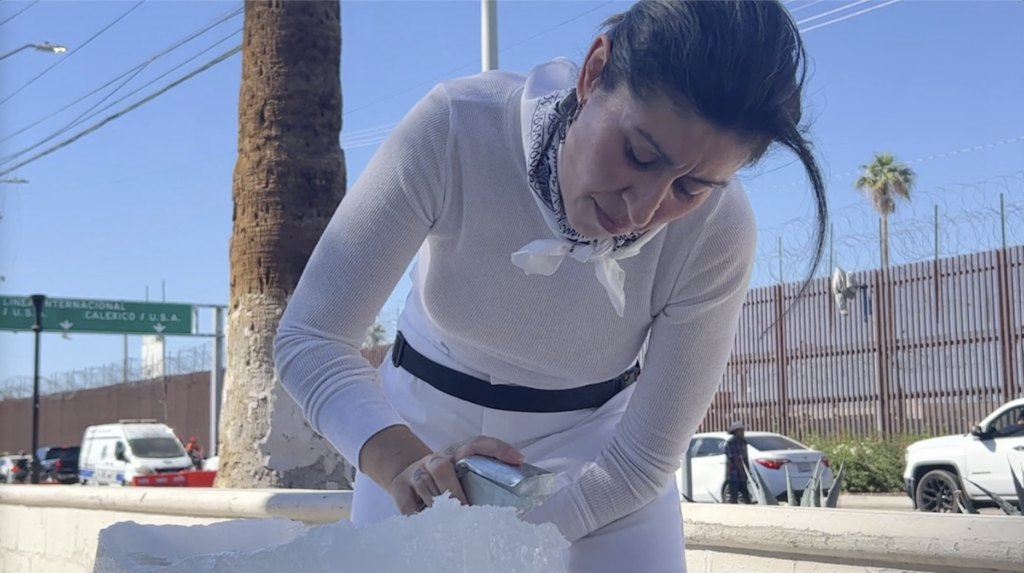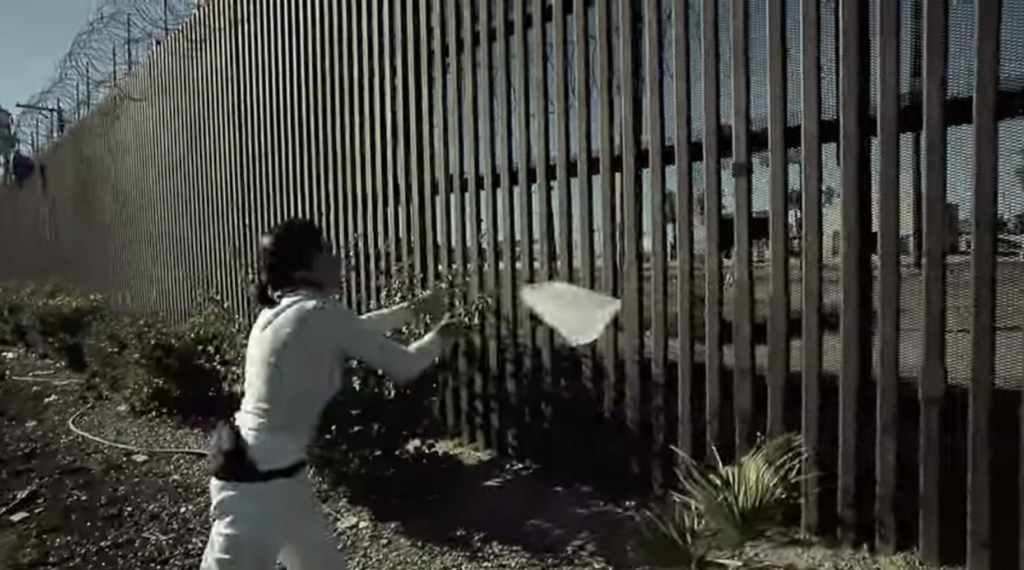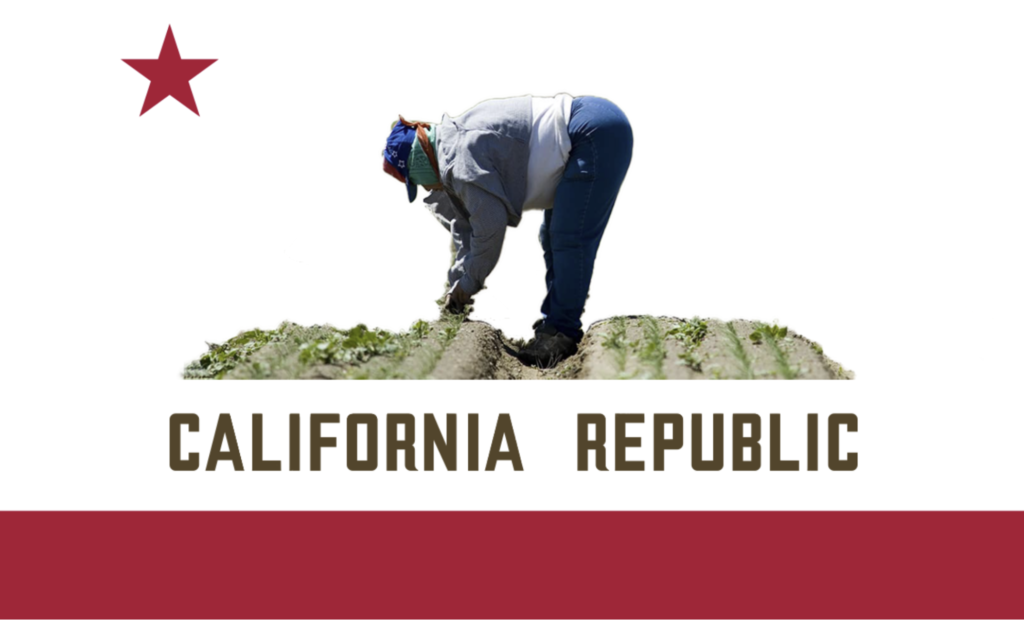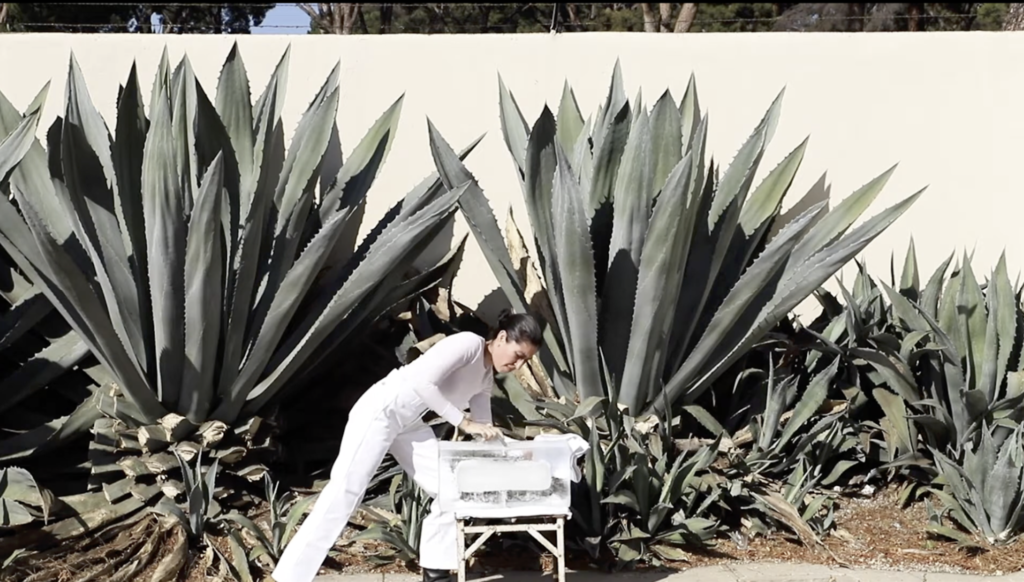Annabel Turrado’s Raspado (Abolish ICE/Abolir ICE) and the Contexts of Durational Performance Art
The following is a guest post by Jill Marie Holslin.
An artist stands on a sidewalk in a park in Mexicali, Mexico at 1:00 PM, under the blazing afternoon sun, bent over an enormous block of ice mounted on a metal stand. Resting on the stand, the top of the ice block hits about mid-thigh in relation to the artist’s body, and she bends down low over it completely to make her motions. She is dressed in a long-sleeved white t-shirt, a white bandana around her neck, white cotton pants and black leather cowboy-style work boots. Around her waist, she wears a black fanny pack, with the zipper side turned outward. As I approach, I see she is shaving the ice with a metal raspador, a handheld ice shaver used in raspado shops by Mexican working-class men to make shaved ice for Mexican-style snow cones. The raspador is a metal tool about the size of a matchbox that fits comfortably in the hand, with a sharp blade on the bottom side, a hollow space inside that fills up with shaved ice, and a top cover that opens and snaps closed again over the bottom container part. As the artist grips the raspador in her right hand, her bent, laboring body moves rhythmically, her right arm and shoulder moving back and forth vigorously scraping the ice. As I get closer, I can see her left hand is resting on a towel, gripping it, and she leans hard into the ice to give more force to her scraping. She puts her whole body into the motion, and her right hip and her arm and shoulder move forward and back as she scrapes the ice. She keeps a tight grip on the frozen mass, allowing the towel to soak up the melt. With her hair pulled back tightly in a short ponytail, I can see she is wearing tiny silver drop earrings.
It is easy to describe this performance. But the term “the performance” begs the question. What are the boundaries of performance and site? What counts as the performance and what is “just context?” The durational performance piece Raspado (Abolish ICE/Abolir ICE) (2020) was staged on a hot Sunday afternoon in a public park located at the US-Mexico border crossing in Mexicali, Mexico as part of the 2023 MexiCali Biennial. The work invites the viewer to notice and consider what it would take to intervene in and even abolish the oppressive systems of border enforcement that shape everyday experience at the US-Mexico border. As performance studies scholar Shannon Jackson and art historian Julia Bryan-Wilson point out with a nod and a wink to Michael Fried’s critique of minimalism, “it is not only the immediate performative body of the artist that counts as the piece, the contexts that frame durational art—whether rhetorical, or national, or institutional—matter a great deal.” I argue that it is the immediacy of this performance, its site-specificity, and its pairing with another performance which open up complex readings for the viewer. This performance by artist Annabel Turrado, stages a commonplace situation that implicates the viewer in a set of expectations related to time, place and duration, prompting a recognition of her own body and relationships to others in the charged site of the US-Mexico border.
The performance on October 15, 2023 took place on the Mexican side of the border at Parque de los Heroes de Chapultepec, alongside Avenida Internacional, the street that runs along the US-Mexico border just a few blocks from the Mexicali-Calexico border crossing. A rich tapestry of visual and sound elements formed the backdrop of the artist’s performance. Just over the shoulder of the laboring body of the artist, I could see a giant green and white road sign: “Linea Internacional Calexico/USA” with white arrows indicating various lanes for SENTRI, for bus and RV, and for automobiles and motorcycles. (fig. 1). A constant flow of honking cars passed on the street next to 30-foot tall iron bars of the border wall covered with glistening steel razor wire. Alongside the motorists, a dozen street vendors passed up and down the street all afternoon, their wide-brimmed straw hats bopping in and out of lines of cars. Their bodies draped with merchandise, stacks of car window sunshades, plastic woven shopping bags, bright red baseball caps, and heavy cotton sarapes. Another vender, a singer, walked back and forth all afternoon singing Mexican pop songs into a karaoke microphone, projecting melodies through an enormous speaker he carried slung over his shoulder.

Turrado’s solo performance took place this day in tandem with a group performance at the same site at the US-Mexico border crossing at Mexicali/Calexico: Electronic Disturbance Theater 3.0, the final act in a 3-part experimental opera that addresses the ubiquity and normalization of technologies of border security and surveillance. The pair of performances, framed by the organizers as “border activations,” took place during a weekend of gallery shows and performance pieces that culminated a year-long series of events of the 2023 MexiCali Biennial. The MexiCali Biennial was founded in 2006 to recenter regional artists, art spaces and the complexity of the Southern California-Northern Baja border region. This year’s theme, “Land of Milk & Honey,” is a reference to John Steinbeck’s portrayal of the region as a corrupted Eden, and the constellation of projects raised questions about cultural and regional practices related to foodways and the mythologies about California as the land of opportunity and abundance. The biennial happened in the shadow of dramatically increasing levels of global migration prompted by war, violence, food insecurity and shifting US migration policies creating a crisis at the US-Mexico border region.
A raspadero on the sidewalk: the performing body
There is an immediacy to this performance. I am sitting on the grass on the Mexican side of the border with eight or ten other audience members, just a few feet from the artist and we chat as we watch her work. A young couple walk past pushing a stroller, their two young children trailing behind, and they don’t stop or even seem to notice the scene. A man rides by on his bike. We have dumped our backpacks, water bottles, and camera bags on a park bench where a videographer is squatting behind a tripod, documenting the performance on video. The audience is small and sits nearby—we are twenty or so people, mostly other artists and curators involved with the biennial, sitting in small groups on the grass. We know each other now having met at other gallery events over the weekend. Nearby a man soaps up and washes his hair in the park’s water sprinkler, and another man wearing a bandana and work hat, sleeps soundly, sprawled out on a park bench, his backpack and work tools stowed safely beneath him.
From time to time, someone gets up to take a photograph of the artist, and I follow suit. I nod to the videographer and then move around the artist with my iPhone, making my own video documentation and photographs. I stand close, right next to her moving hand, and through my lens I see the tension in her wrist as she grips the metal scraper and pushes it over and over into the ice. Turrado is a Los Angeles-based performance installation artist, director and theater creator, and this work is typical of Turrado’s artistic practice, based in durational performance and contemplative dance. Her hands and fingers are probably stiff and aching now from contact with the ice and metal, while the blazing sun beats down on her head and back. I watch her hand moving back and forth, back and forth, not stopping. The rhythmic, resonating sound of the raspador scraping on the ice sounds oddly musical. I’m close enough to see her face. A big lock of her bangs has fallen out of the ponytail and flops down over her forehead. But her face betrays no tension. She doesn’t look up or respond to the audience. She works calmly, deliberately, with smooth motions. Her movement is almost meditative.
The other performance that day, by Electronic Disturbance Theater, framed the durational performance, gesturing to the national and international contexts of border security that encode the border as a site of tension and danger. Eight or ten performers separated into two groups—one on the US side and the other in the park with us on the Mexicali side. Dressed in orange prison jumpsuits, yellow safety vests and bright red MAGA hats, they walked back and forth along both the US and Mexican sides of the border wall producing a cacophony of technologically-generated sound and movement. One performer standing next to the border wall read a text into a microphone, and another walked along the sidewalk operating a drone that projected a recorded message, descriptions of the billions spent by the US Department of Homeland security on border security apparatus, the lucrative contracts, detailed descriptions of sensors, lights, and other border technologies, the work of agents Customs and Border Enforcement. A third group carried an enormous antenna to “transmit” signals to the other side.
I stepped back and put down my camera to watch the artist work on the ice block, and she stood up suddenly and held the raspador over the sidewalk—it was clogged with ice–and she shook it out, picking the ice out with her fingers, preparing for the next round of scraping. She took the towel and wiped down the ice block, then folded it in half and half again, twisting it to wring out the water. It made a splattering sound on the sidewalk. She must be thirsty, I thought. The temperature app on my cell phone read 95 degrees, and the afternoon desert sun was wearing on me. She had been there working for over an hour, her body bent down completely over the ice block. This is the kind of bending over that strains your lower back, I thought. This is not an ergonomic workstation. She stood up again to wring out her towel, letting the ice cold water splatter onto the sidewalk. Up overhead, the drone flew past, a buzzing sound and a loud voice coming from overhead, reports of deportations and data about ground sensors installed just yards from where we were sitting.
The shaping of time: implicating audiences in the transnational
The performance lasted for two hours, from 1:00 to 3:00 PM, and I had to leave before it ended to embark on a two-and-a-half-hour drive back home through the rugged Rumorosa mountains to Tijuana. Although I did not witness the ending, the video documentation posted on the MexiCali Biennial website shows online viewers some highlights of the performance and the climactic ending. After two hours of shaving ice, the artist picks up the remaining chunk with both hands, carries it across the street, and throws it hard against the bars of the border wall that separates Mexicali, Mexico from her sister city Calexico, California. The ice shatters and falls to the ground. (fig. 2).

It is indeed easy to describe the performance. We are watching an artist make shaved ice. Yet, as performance studies scholar Edward Scheer notes, “the phrase ‘durational art’ implies a specific construction of time, a deliberate shaping of it to effect a particular experience for the viewer or the audience.” Rather than a performance where a passive audience simply watches the spectacle of the artist at work, this performance situates the viewer in a role, and brings them into an active relationship with the performance by referencing the experience of customer and vendor selling street food. Typically, at a raspado stand, you stop and wait a few minutes while the vendor shaves the ice and serves you. Turrado’s durational piece draws the viewer into a process of waiting. As an audience sitting in a park in front of the border wall at the US-Mexico border, we were situated in a highly charged site of waiting where “waiting” means many different things for different people.

Another visual reference for the scene is the artist’s own piece California Republic (2021), a series of digital collages that depict workers on the site of field labor that southern Californians rarely see in spite of the ubiquitous presence of heirloom tomatoes and fresh spinach on our grocery shelves. (fig. 3). Digital images of workers are collaged into the image of the California state flag, the workers in full body profile, bent over while picking crops in a field, dressed in hats, bandanas and multiple layers of clothing, the blazing sun reflecting off the backs of their jackets. In each piece in the series, the scene of a worker in the field is nestled in the center of the California flag, and it stands in for the flag’s emblem of the brown bear in full body profile walking over a patch of green grass, both recalling and replacing it. Turrado’s performance in front of the US-Mexico border wall in Mexicali recreates these collage images as a tableau vivant, bringing the workers to life and along with them, bringing the audience into the temporal space of working-class labor, the long workday of repetitive motion, back bent under the blazing sun. (fig. 4).

As Jackson and Bryan-Wilson point out, durational performance can make audiences aware of the dynamics among subjects and space in the performance site itself: “These experiments with time respond to the local economic politics of particular regions as well as to transnational circuits of exchange. Questions of time in art interact with larger questions of migration, capitalism, and mobility in a global world.” Turrado’s durational performance breaks down clear distinctions between temporal and spatial, shaping time into a process of waiting that opens up awareness of what it means to wait in this space. Out on the street front of us, hundreds of motorists sit in their cars waiting for an hour or more to cross the border, while street vendors wait patiently for 8-10 hours a day to sell their goods to a passing buyer. Across the street at the border wall, the performance by Electronic Disturbance Theater recalls the interrelationship between migrants and border patrol agents, waiting for hours, days or even weeks in the hot desert sun caught up in a brutal waiting game at the border. As audience members, our waiting is shaped by the privilege of being able to stand up and walk around, sit down under the shade of a tree, to leave when we want to.
By implicating the viewer in the transnational circuits of exchange at the border and its dynamics of waiting, Raspado (Abolish ICE/Abolir ICE) (2020) opens up the possibility in the audience for a more complex understanding of our place at an international border in relation to others. As we wait, we may come to feel righteous indignation and anger at the outrageous expenditure of US tax dollars on an absurd border enforcement system. But through the shared experience of waiting for two hours under the hot sun for the conclusion of a performance, we may also come to feel some empathy with the workers whose daily lives are shaped by waiting and working in the sun.
Can I get it on Netflix?
This performance was the third iteration of this same work. The original performance was produced in 2020 as a 210-minute performance for camera. (fig. 5). The resulting video (approximately four minutes in length) was produced as a single channel and then 9-channel video and collapses the duration into three minutes and nine small frames on the screen. (fig. 6). The artist appears in profile view, bending over and shaving a block of ice. Dressed in the same white cotton outfit with black work boots, her bent, laboring body appears in the video against the backdrop of two enormous 10-foot-tall green agave plants, standing on a sidewalk in the bright sun against a white stucco wall. The relationship between a live durational performance and its video documentation raises questions about the potential of performance to implicate and engage an audience.

As film studies scholar Weihong Bao notes, “placing duration in cultural, spatial, and experiential contexts becomes a more complex way to engage questions of time and space and the social role of art.” Bao notes that the widespread availability of screens increases the intensity of our experience of these media. Yet, as Bao argues, the greater access offered by a gallery or a museum setting can curtail the critical political agency of a durational performance as museums increasingly operate on “a consumption mode of distraction.” The very duration of durational performance comes into conflict with the financial demands of museums to maximize the number of viewers and keep them moving through the exhibits.

In his essay on performance documentation, scholar Philip Auslander reflects on the difference between the live event and documentation, noting that the live event is not necessarily more “authentic” than a performance documentation. In theatrical documentation, the primary intended audience is the audience for the documentation, not for a live event. Auslander notes,
“The performances in the documentary category work differently, at least to an extent, because they generally have a dual existence: they are framed as performances by being presented in galleries or by other means and there is an initial audience to which the performer assumes responsibility as well as a second audience that experiences the performance only through its documentation. But this difference is much less substantial than it may appear.”
The crucial difference, for Auslander, is that in most performance documentation—theatrical or documentary—the main purpose and focus of the documentation is to create a record of the action and the body of the performer,
“to make the artist’s work available to a larger audience, not to capture the performance as an “interactional accomplishment” to which a specific audience and a specific set of performers coming together in specific circumstances make equally significant contributions… In that sense, performance art documentation participates in the fine art tradition of the reproduction of works rather than the ethnographic tradition of capturing events.”
In his distinction between works and events, Auslander gestures to an important issue in durational performance. If, as Jackson and Bryan-Wilson argue, the contexts that frame durational art “matter a great deal,” then what do we make of the relationship between the live performance on the sidewalk of a park in Mexicali and the documentation of this performance on video. Are they the same work of art, as Auslander suggests?
In the case of Raspado (Abolish ICE/Abolir ICE) (2020), the active presence of the audience at the site is essential to the production of the meaning of this performance. The duration–the long time spent waiting in a specific place–is a necessary element that implicates viewers and the contexts of the site in a dynamic exploration of the meaning of place and time in a global world.
Bibliography
“About.” MexiCali Biennial. accessed November 19, 2023.
Auslander, Philip. “The Performativity of Performance Documentatio.” PAJ: A Journal of Performance and Art 28, no. 3 (September 2006): 1-10.
Bao, Weihong. “Reflections on Durational Art.” Representations, no. 136 (Fall 2016): 132-172.
Diaz, Lizbeth and Daina Beth Solomon. “Record numbers of migrants head to US border, in fresh test for Biden. Reuters. September 22, 2023. https://www.reuters.com/world/record-numbers-migrants-head-us-border-fresh- test-biden-2023-09-21/.
Jackson, Shannon and Julia Bryan-Wilson. “Time Zones: Durational Art and Its Contexts.” special issue Representations. no. 136 (Fall 2016): 1-20.
“Land of Milk & Honey at the Borderlands October 13-December 2, 2023.” (Video)
MexiCali Biennial. accessed November 19, 2023. https://mexicalibiennial.org/.
Scheer, Edward. Introduction: The end of spatiality or the meaning of duration. Performance Research 17, no. 5 (2012): 1-3.
Turrado, Annabel, “Raspado.” ¡Ay Ay Ay! Video installations. Performance. Artist website. accessed November 6, 2023. https://annabelturrado.com/
_____. “CV.” Annabel Turrado. Artist website. accessed 6 November 2023. https://annabelturrado.com/

